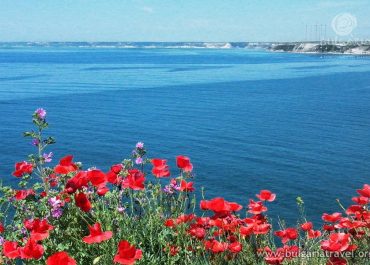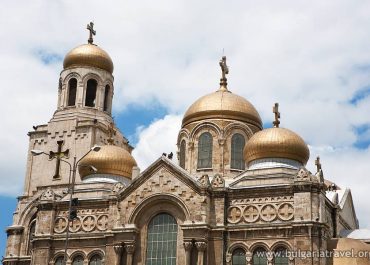
Evksinograd
The Evksinograd Residence is located at a distance of 8 kilometers north of Varna and lies on a 3-kilometer coastline in close proximity to the resort of St. Constantine and Helena. The complex used to be a royal summer residence for the monarchs who ruled Bulgaria after the liberation of the country from the Ottoman Dominion (1878) – Alexander Battenberg, Ferdinand and Boris the 3rd.
Knyaz Battenberg visited Varna in 1880 and he was welcomed at the monastery “St. Dimitar”, which was situated at the same place, where now the residence stands. The monarch liked the local nature so much, that two years later the Varna municipality bestowed him the monastery and its adjoining lands.
Knyaz Battenberg immediately began building his palace, which was called by the local people Sandrovo (named after him), but the project was completed in the period 1887 – 1900 by his successor – Knyaz Ferdinand. The exterior of the palace is very similar to the French Renaissance palaces of the 18th century. The interior is also quite impressive – large halls, beautiful decorations, stylish English furniture, authentic marble fireplaces, French chandeliers, and wall and fireplace clocks, inlaid with gold, rare paintings, hanging on walls, covered in golden silk wallpapers. In 1893 the palace of Sandrovo was renamed to Evksinograd. The new name came from the ancient Greek name of the Black Sea – Evksinos Pontos. One of the first power plants in Bulgaria was built at the palace in the same year.
The palace park is an integral component of the Evksinograd complex. Knyaz Ferdinand attracted French park architects to design the 800 decare park in 1888. The project involved a rare tree species collection – from black oak to Atlantic cedar, which are the only species on the Balkan Peninsula. The bare and stony areas were covered in fertile soil, mostly taken from the valley of the Kamchiya river. Greenhouses were built northeast of the palace for wintering of the palm trees and flower production. More than 500 flower species and 200 sapling species are grown there and in the arboretum.
The park contains several district zones: central (with the palace), Greek garden, English garden, Riverside, Beach and production areas. Each one of them is unique by its specific look and characteristics. The most elegant and representative part of the park is the space in front of the palace, which has a lake with a bronze statue of Neptune, delivered from France.
In 1891, a palace winery was built as a part of the complex and a successor of the old monastery cellar. The initiative belongs to Knyaz Ferdinand, and the design was made by a German architect. The building is a picturesque house in Bulgarian Revival style. It includes two underground levels, a host wing, a laboratory, a bottling workshop, administrative offices and a degustation room. The size of the winery is one of a small boutique production.
The wines of Evksinograd are nowadays known for their excellent quality. For the winery production are used grapes from Chardonnay, Riesling, Traminer, Muscat Ottone and Vratsa Muscat. The white wines are produced by classical and modern methods and are stored in oak barrels. The winery is proud with its good brandy and organizes degustation of its best products for guests.
Another landmark in the area of the residence is the ruins of the late ancient fortress Kastritsi in the northeastern part of the park.
Evksinograd is open to tourists. The tourist route includes the historical core of the park with the greenhouses, the palace building, the sundial (gift for tsar Ferdinand by queen Victoria), the chapel St. Dimitar and the winery.
The complex offers accommodation. At the disposal of the guests, there is a restaurant, a barbecue, as well as opportunities for practicing various sports, such as table tennis, tennis, basketball, volleyball, fitness, bowling, water skiing, surfing, etc.
Тourist information center – Varna
Time in season (May to September )
• Every day- 9.00-19.00
Time in the off-season (October to April )
• Monday to Friday –8.30-17.30
St. Kiril and St. Metodiy Str., city of Varna
Tel: +359 52 820690
Tel: +359 882 644679
E-mail: office@varnainfo.bg
Websait: visit.varna.bg
Contacts with Evksinograd Complex
Tel: +359 52 393 140
Tel: +359 52 393 150
E-mail: residence_euxinograde@abv.bg
Websait: www.travel.government.bg
The Evksinograd Residence is located at a distance of 8 kilometers north of Varna and lies on a 3-kilometer coastline in close proximity to the resort of St. Constantine and Helena. The complex used to be a royal summer residence for the monarchs who ruled Bulgaria after the liberation of the country from the Ottoman Dominion (1878) – Alexander Battenberg, Ferdinand and Boris the 3rd.
Knyaz Battenberg visited Varna in 1880 and he was welcomed at the monastery “St. Dimitar”, which was situated at the same place, where now the residence stands. The monarch liked the local nature so much, that two years later the Varna municipality bestowed him the monastery and its adjoining lands.
Knyaz Battenberg immediately began building his palace, which was called by the local people Sandrovo (named after him), but the project was completed in the period 1887 – 1900 by his successor – Knyaz Ferdinand. The exterior of the palace is very similar to the French Renaissance palaces of the 18th century. The interior is also quite impressive – large halls, beautiful decorations, stylish English furniture, authentic marble fireplaces, French chandeliers, and wall and fireplace clocks, inlaid with gold, rare paintings, hanging on walls, covered in golden silk wallpapers. In 1893 the palace of Sandrovo was renamed to Evksinograd. The new name came from the ancient Greek name of the Black Sea – Evksinos Pontos. One of the first power plants in Bulgaria was built at the palace in the same year.
The palace park is an integral component of the Evksinograd complex. Knyaz Ferdinand attracted French park architects to design the 800 decare park in 1888. The project involved a rare tree species collection – from black oak to Atlantic cedar, which are the only species on the Balkan Peninsula. The bare and stony areas were covered in fertile soil, mostly taken from the valley of the Kamchiya river. Greenhouses were built northeast of the palace for wintering of the palm trees and flower production. More than 500 flower species and 200 sapling species are grown there and in the arboretum.
The park contains several district zones: central (with the palace), Greek garden, English garden, Riverside, Beach and production areas. Each one of them is unique by its specific look and characteristics. The most elegant and representative part of the park is the space in front of the palace, which has a lake with a bronze statue of Neptune, delivered from France.
In 1891, a palace winery was built as a part of the complex and a successor of the old monastery cellar. The initiative belongs to Knyaz Ferdinand, and the design was made by a German architect. The building is a picturesque house in Bulgarian Revival style. It includes two underground levels, a host wing, a laboratory, a bottling workshop, administrative offices and a degustation room. The size of the winery is one of a small boutique production.
The wines of Evksinograd are nowadays known for their excellent quality. For the winery production are used grapes from Chardonnay, Riesling, Traminer, Muscat Ottone and Vratsa Muscat. The white wines are produced by classical and modern methods and are stored in oak barrels. The winery is proud with its good brandy and organizes degustation of its best products for guests.
Another landmark in the area of the residence is the ruins of the late ancient fortress Kastritsi in the northeastern part of the park.
Evksinograd is open to tourists. The tourist route includes the historical core of the park with the greenhouses, the palace building, the sundial (gift for tsar Ferdinand by queen Victoria), the chapel St. Dimitar and the winery.
The complex offers accommodation. At the disposal of the guests, there is a restaurant, a barbecue, as well as opportunities for practicing various sports, such as table tennis, tennis, basketball, volleyball, fitness, bowling, water skiing, surfing, etc.
Тourist information center – Varna
Time in season (May to September )
• Every day- 9.00-19.00
Time in the off-season (October to April )
• Monday to Friday –8.30-17.30
St. Kiril and St. Metodiy Str., city of Varna
Tel: +359 52 820690
Tel: +359 882 644679
E-mail: office@varnainfo.bg
Websait: visit.varna.bg
Contacts with Evksinograd Complex
Tel: +359 52 393 140
Tel: +359 52 393 150
E-mail: residence_euxinograde@abv.bg
Websait: www.travel.government.bg
Virtual map
Photos
© All images, advertising and video materials and/or other information published on this website are property of the Ministry of Tourism and are protected by the Law on Copyright and Related Rights, according to the Bulgarian laws to all applicable international and relevant acts of the European Union.





